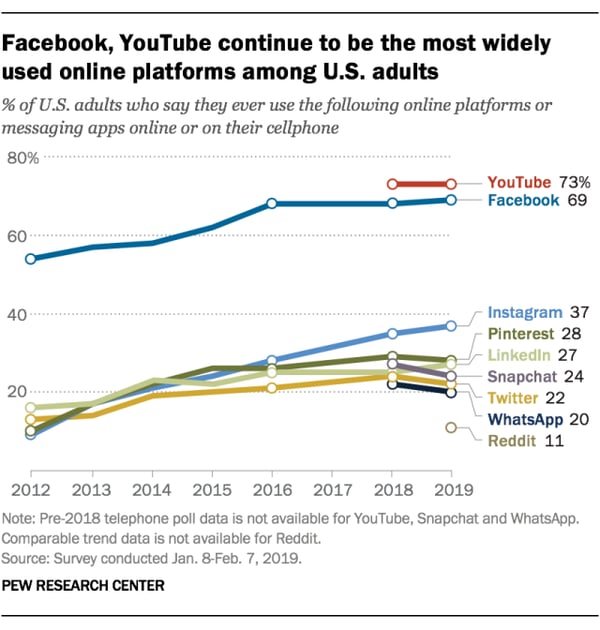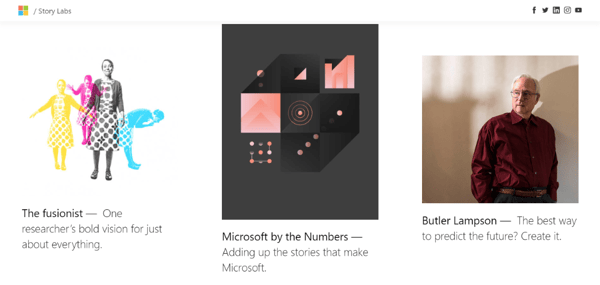
It’s almost here. We’ve nearly reached the 2020s, a decade that once sounded positively futuristic to our ears.
As we draw closer to this landmark year, what can we look forward to in content marketing? What are some trends cropping up right now, and which ones will gain more traction as the year progresses?
To start, think about this: content marketing as an industry is careening toward a worth of over $400 billion. That demonstrates both the investment and confidence businesses have put into content.
We’re getting savvier about this whole “content” thing, and the trends for 2020 reflect that. Let’s take a look.
Content personalization is the process of gathering and analyzing data about your audience to deliver content that meets their needs or interests to a T.
As you might guess, this uber-personal experience allows you to speak to the heart of specific visitors at their exact level of brand awareness. This draws them into your marketing lifecycle much more effectively than a static page with content targeting anyone and everyone (that broad scope is a catch-22 – it’s meant to appeal to all, but actually appeals to none).

According to research from Evergage, about 62% of marketers currently use the most common form of content personalization, segmentation, to provide better experiences for their audiences. At the same time, only 32% of marketers think the industry is succeeding in delivering truly personalized experiences.

In other words, there is a ton of room for improvement. In 2020, look for marketers to continue to hone their content personalization strategies and improve the way they target their readers.
That means more and better data collecting processes; more in-depth audience research and analysis; and an emphasis on content created purposefully for specific readers.
In recent years, AR and VR technology have become more widespread. For those who don’t know, VR (virtual reality) is when you are immersed in a totally-new, made-from-scratch virtual world. AR (augmented reality) is when the real world around you is augmented, or enhanced, with digital features.
Most people on Snapchat and Instagram are well-acquainted with AR in particular. Both social platforms give users an array of AR filters to choose from that alter your face or the immediate world around you.

Snapchat even has AR games (called “Snappables”) you can play, and a feature called “Scan” that lets you apply AR to your world.
While virtual reality lags behind augmented reality in popularity, that’s only because the technology is more expensive. (A good VR headset used to set you back by at least $600. Today, newer models, including “budget” headsets, have reduced that cost by $200-300.)
Finally, mobile technology for both AR and VR is more accessible – and cheaper – than ever. Those willing to dive in and play around with interactive, immersive content may benefit greatly (“first adopter” status, anyone?).
Content marketers have the ability to create their own AR filters for Snapchat, Instagram, and Facebook. VR platforms like Rec Room, VRChat, and even Fortnite are becoming places where people gather to chat, hang out, and socialize.
So far, marketing opportunities on these platforms are limited, but this represents an opportunity for creative content marketers. As VR gains ground, immersive ads are touted as the next way to get your message across to new customers.
With the growth and popularity of visual social media networks like Instagram and Snapchat, we are seeing social move closer to image-dependence. People prefer sharing their lives through visual media, and they love having conversations through pictures and video, too.
Seventy-three percent of US adults say they use YouTube, which outstrips even Facebook (69%) as the most-used media platform. Instagram comes in third place, with 37% of adults reporting usage.

And among the newer entries in the social media world, Instagram is the fastest-growing – from 2018-2019, the platform added the most new active users with 36 million.

Among teens, Snapchat is the most-used network, followed by YouTube and Instagram. All are channels that depend on the power of the visual.

Plus, think about this telling stat: Content with images gets 94% more views than content without. All this adds up to mean visual-heavy social media marketing will matter a lot in 2020.
Telling great, engaging stories will never go out of style, and that remains true for content marketing as well. These days, most marketers are realizing they don’t need fancy gimmicks as long as they tell a clear story that resonates deeply with their audiences.
It doesn’t have to be a brand story, either. Sometimes, the most successful storytelling in content marketing revolves around the customer as the protagonist, and how the brand helped them reach their goals or solved their problems (case studies, anyone?).
Stories bring people together, uniting us around common, universal themes of humanity. Good stories pull at your emotions, make you think, or echo a thought or feeling you’ve had before, but never found the courage to voice.
TIP: You can even tell a great story to your potential buyers through holding conferences, like the Content Tech Summit 2019.
Here a few examples of current brands using stories in their content marketing to incredible effect (expect more content marketing with a storytelling focus in 2020).
The Farmers Insurance Learn from Experience blog features stories from real customers.

Microsoft Story Labs
Microsoft Story Labs looks and reads like a digital magazine. It features tech news, profiles, and stories on people and brands improving the world through technology.

By 2020, voice and image search will account for half of all searches on the internet, according to Mary Meeker, who spoke about hands-free computing at Code Conference 2019. That’s right: half. That amounts to about 200 billion voice searches.
|
TIP: See our rundown of trending voice search statistics to learn just how important voice search technology is becoming to modern marketing practices. |
As content marketers, we can’t ignore how ubiquitous voice search is becoming. As we move closer to 2020, we need to think about optimizing content for more direct queries and questions, and how we can give our audiences who use voice search the answers and information they need.
Artificial intelligence is another technology that has made lots of strides in recent years. By 2020, we’ll be looking at more and more AI chatbots handling 1:1 conversation with customers.
Granted, we’re not talking about human-caliber conversations, rather scripted chats with bots responding to common customer questions, problems, and inquiries.
Case in point: by 2023, chatbots are projected to drive $112 billion in retail sales. That’s because consumers are getting more comfortable interacting with chatbots; chatbot AI is getting better; and businesses that implement chatbots in some areas of customer service will cut costs by doing so.
|
TIP: Get ready to adopt chatbots to increase response speed and overall customer satisfaction by implementing chatbot software for your customer service needs. |
Of course one of the best aspects of chatbots is their availability. They can be present at customer touchpoints 24/7 – no need for a tired human behind the screen. As we head into 2020, a key determiner for the success of chatbots are the people working behind-the-scenes on the scripts, language – using natural language processing (NLP) tools, and queries the bots can handle.
Don't worry, we will only send you the good stuff.
Anymore, consumers are connecting with brands across channels, including websites, blogs, YouTube, and social media accounts.
How do you make sure your brand voice is consistent across channels? Which social media platforms should you be on? How do you know what/when/where to post for the best engagement?
These questions are cropping up more often, and in 2020, more brands will be creating omnichannel content strategies to better guide their marketing endeavors.
As successive Content Marketing Institute reports have shown, as we get wiser about content marketing, more of us see the need to have a strategy in place. And those brands with strategies do better overall than those without one.
In 2018, 37% of marketers reported having a documented content strategy.

From CMI’s 2018 report

From CMI’s 2019 report
The next step, naturally, is not just having a slapped-together strategy – it’s having a refined strategy, a game plan that prepares you for every possibility. As we move to 2020, more marketers will strategically plan not just for website content, but also for content across ALL their channels.
Brand collaborations are nothing new, but in 2020, we’ll see more content marketers, brands, and influencers teaming up to share the wealth between them – their audiences, reach, and authority.
Collaborating can be as simple as inviting a like-minded expert from a relevant brand in an adjacent industry to guest blog on your site. In return, you create a guest post for their blog. Mutual link-sharing and promotion ensue. You both reach larger audiences. Win-win.
|
TIP: G2's guest post program is always seeking new writers. Would you like to contribute to a site with more than 1.5 million monthly readers while boosting your brand and name recognition? SIgn up to write today! |
Another way to collaborate is to create content together. We see this everywhere in content marketing, and that’s not going to stop any time soon. For a large-scale example, look at the partnership between National Geographic and Travel New Zealand.

With articles, photos, and video showing you the wonders of New Zealand, Tourism New Zealand leverages National Geographic’s storytelling abilities to reach a larger audience. Meanwhile, Nat. Geo. builds on their reputation of stellar journalism.
Another content partnership: Spotify teaming up with Vox to produce an educational, yet fun video on how your Discover Playlist is created.
Traditional marketing tactics have been around for a very long time. All of us grew up with ads blaring at us from a TV screen, from billboards, and in magazines and newspapers.
We know how it works. We know exactly when a brand is selling to us. That’s why, when a company instead pivots to help us, educate us, or entertain us – no strings attached – we feel a breath of fresh air.
In today’s oversaturated landscape of ads and content, the stuff we notice and appreciate is the stuff that touches our pain points and heals them. Everyone is selling something, and everyone wants to sell more. In 2020, the brands that will stand out are the ones who will instead authentically connect with their audiences through purposeful, useful, engaging content.
Sales are a natural byproduct of trust built and solidified with consumers. However, the most successful will put their customers’ needs first – not sales. That will be the definition of authenticity in 2020.
| TIP:Marketers also use reviews to grow their brand awareness and connect with buyers. Use customer feedback to create content that adds authenticity and credibility. |
2020 is still months away. We can only predict and speculate on what will truly rule the content marketing industry throughout that first year of the auspicious ‘20s. Content personalization, chatbots, VR and AR, brand authenticity, storytelling, and more – these will surely reign next year.
But what else might be coming? And more importantly...are you ready?
Are you ready to amplify your content marketing strategy to get your company on the map? Start preparing by discovering the right content marketing software for your needs, with user reviews and ratings from real people on G2.
Julia McCoy is a top 30 content marketer and has been named a Forbes industry thought leader. After dropping out of college at 19, she grew her content agency, Express Writers, to $4.3M in revenue completely through content marketing. Julia is the author of two bestselling books on content marketing and copywriting, certifies content strategists in her training course, The Content Strategy & Marketing Course, and most recently, teaches growth-focused content marketing at The Content Hacker. Julia lives in Austin, Texas with her daughter and husband.
Which would you understand more easily - a block of text explaining how to tie a Double...
 by Kelly Wade
by Kelly Wade
Over the last few years, ephemeral content has become a popular social media phenomenon.
 by Hugh Beaulac
by Hugh Beaulac
Which would you understand more easily - a block of text explaining how to tie a Double...
 by Kelly Wade
by Kelly Wade



